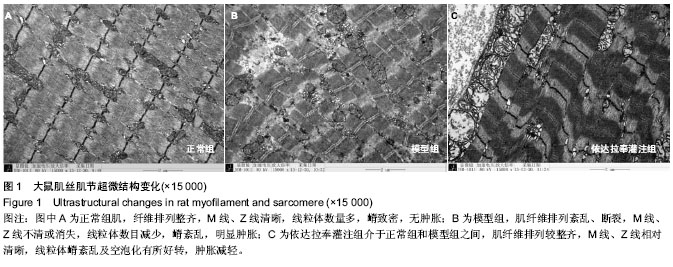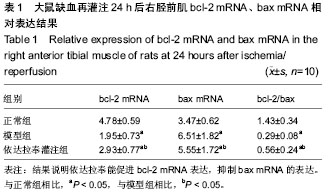| [1] 郑灿镔,朱庆棠,顾立强,等.四肢主要动脉钝性损伤的伤情特点分析[J].中华损伤与修复杂志:电子版, 2011, 6(4): 013.
[2] 陈主初,郭恒怡,王树人.病理生理学[M].北京:人民卫生出版社, 2005:190-191.
[3] Gillani S, Cao J, Suzuki T, et al. The effect of ischemia reperfusion injury on skeletal muscle. Injury.2012;43(6): 670-675.
[4] 孙德舜,韩继明,王小鹤,等.肢体缺血再灌注损伤的研究进展[J].中国骨伤, 2004,17(7): 446-448.
[5] Hsieh CH, Jeng JC, Jeng SF, et al. MicroRNA profiling in ischemic injury of the gracilis muscle in rats. BMC Musculoskelet Disord. 2010;11(1): 123.
[6] Gyurkovics E,Aranyi P,Stangl R,et al.Postconditioning of the lower limb—protection against the reperfusion syndrome. J Surg Res. 2011;169(1):139-147.
[7] Bolcal C, Yildirim V, Doganci S,et al.Protective effects of antioxidant medications on limb ischemia reperfusion injury. J Surg Res. 2007;139(2):274-279.
[8] Irie H, Kato T, Ikebe K, et al. Antioxidant effect of MCI-186, a new Free-Radical scavenger, on ischemia-reperfusion injury in a rat hindlimb amputation model. J Surg Res.2004;120(2): 312-319.
[9] Kikuchi K, Uchikado H, Miyagi N, et al. Beyond neurological disease: New targets for edaravone (Review). Int J Mol Med. 2011;28(6):899-906.
[10] Tonon J, Cecchini AL, Brunnquell CR, et al. Lung injury-dependent oxidative status and chymotrypsin-like activity of skeletal muscles in hamsters with experimental emphysema. BMC musculoskelet disord.2013;14(1): 39.
[11] Qi X, Okuma Y, Hosoi T, et al. Edaravone protects against hypoxia/ischemia-induced endoplasmic reticulum dysfunction. J Pharmacol Exp Ther. 2004;311(1):388-393.
[12] Kikuchi K, Takeshige N, Miura N, et al. Beyond free radical scavenging: Beneficial effects of edaravone (Radicut) in various diseases (Review). Exp Therapeutic Med.2012;3(1): 3-8.
[13] Lee BJ, Egi Y, van Leyen K, et al. Edaravone, a free radical scavenger, protects components of the neurovascular unit against oxidative stress in vitro. Brain Res. 2010;1307: 22-27.
[14] Wu S, Sena E, Egan K, et al. Edaravone improves functional and structural outcomes in animal models of focal cerebral ischemia: A systematic review. International J Stroke.2014; 9(1): 101-106.
[15] 张连元,杨林.生理科学实验教程[M]北京:人民军医出版社, 2001:29-30.
[16] 胡跃林,于长隆,钟炎丰,等.止血带缺血预处理对大鼠骨骼肌缺血再灌注损伤的保护作用——组织病理学研究[J].中国运动医学杂志, 2003, 22(2):153-155.
[17] Pfaffl MW. A new mathematical model for relative quantification in real-time RT–PCR. Nucleic Acids Res. 2001; 29(9): e45-e45.
[18] 段永壮,王增涛,钟世镇,等.依达拉奉对深低温保存大鼠断肢再植后缺血再灌注损伤的影响[J].中国组织工程研究与临床康复, 2007,11(8):1416-1418.
[19] Iida H, Nagasaka T,Shindo K,et al.Effect of the free radical scavenger edaravone on peripheral nerve ischemia-reperfusion injury. Muscle & Nerve.2009;40(4): 582-588.
[20] Crawford RS, Hashmi FF, Jones JE, et al. A novel model of acute murine hindlimb ischemia. Am J Physiol Heart Circ Physiol. 2007;292(2):H830-H837.
[21] 邢宏昶,姚鲲,侯磊,等.依那普利后处理对肢体缺血再灌注诱发大鼠心肌损伤的影响[J].中华麻醉学杂志, 2013, 33(3): 360-362.
[22] 张敬东,易先宏,李玉安.缺血再灌流股骨头骺影响关节软骨细胞的凋亡[J].中国组织工程研究, 2013, 17(28): 5133-5138.
[23] Pommier Y,Sordet O,Antony S,et al.Apoptosis defects and chemotherapy resistance: molecular interaction maps and networks. Oncogene.2004;23(16): 2934-2949.
[24] Jena S, Chainy G B N, Dandapat J. Expression of antioxidant genes in renal cortex of PTU-induced hypothyroid rats: effect of vitamin E and curcumin.Mol Biol Rep. 2012;39(2):1193- 1203.
[25] Grinberg M, Schwarz M, Zaltsman Y, et al. Mitochondrial carrier homolog 2 is a target of tBID in cells signaled to die by tumor necrosis factor alpha. Molecular and cellular biology. 2005;25(11): 4579-4590.
[26] Chami M, Prandini A, Campanella M, et al. Bcl-2 and Bax exert opposing eff ects on Ca2+ signaling, which do not depend on their putative pore-forming region. J Biol Chem. 2004;279(52):54581-54589.
[27] 谷造华,冯小宁,李永平,等. miRNA-1 和 miRNA-133 在大鼠失神经腓肠肌中的变化规律研究[J].中华细胞与干细胞杂志:电子版,2013, 3(1): 17-20.
[28] 沈燕国,徐建光,顾玉东,等.人体失神经支配骨骼肌 1Na, K-ATP 酶, Ca-ATP 酶及糖原的变化[J]. 复旦学报:医学版, 2002, 29(5): 343-346.
[29] Hori K,Tsujii M,Iino T,et al.Protective effect of edaravone for tourniquet-induced ischemia-reperfusion injury on skeletal muscle in murine hindlimb. BMC Musculoskelet Disord.2013;14(1): 113.
[30] Rajesh KG,Sasaguri S,Suzuki R,et al.Antioxidant MCI-186 inhibits mitochondrial permeability transition pore and upregulates Bcl-2 expression.Am J Physiol Heart Circ Physiol. 2003; 285(5): H2171-H2178.
[31] Liang H, Yu F, Tong Z, et al. Effect of ischemia post-conditioning on skeletal muscle oxidative injury, mTOR, Bax, Bcl-2 proteins expression, and HIF-1α/β-actin mRNA,IL-6/β-actin mRNA and caveolin-3/β-actin mRNA expression in ischemia-reperfusion rabbits. Molecular biology reports.2013;40(1): 507-514. |

